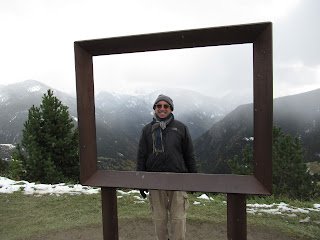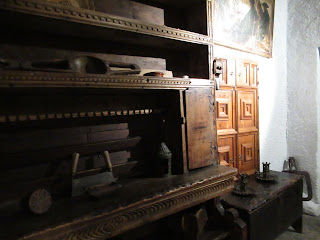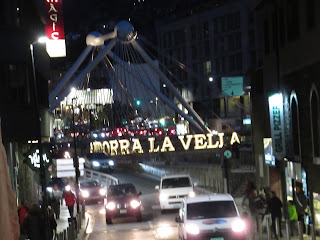When planning our time in Andorra months and months ago, we'd intended to drive to Arcalis, and then take the chairlift to the top of the mountain to hike to two mountain lakes.That would have been a grand plan if snow hadn't already fallen as we weren't properly equipped to hike in the wilderness in the Andorran mountains. We decided to still head to Arcalis and figure out a Plan B once we got there.
I'd thought the 'O' might have stood for the first letter in Ordino for the name of the Ordino-Arcalis bike race but the plaque indicated it represented perfection.
As we drove down to a far lower altitude, I loved seeing these horses but had no idea what type they were. Many of them had bells on, just like the ones we’d seen yesterday afternoon in anther pasture. I stood and watched them for several minutes, just engrossed in the bucolic scene set against the changing colors of the trees in the background.
We couldn't resist stopping at the idyllic 17th century church called Sant Serni de Llorts in the tiny community of Llorts. When we discovered it was closed, we walked around the outside and through the village.
I'll certainly admit to feeling more than a bit of trepidation being so far out on the ledge and I hated looking down through the glass but I did it anyway. I certainly didn't come all that way not to!
Kudos to Steven for joining me down on the ledge because I know he felt far more comfortable back up on the higher overlook that was on terra firma!
Because Andorra la Vella was nestled in the valley, there was no snow and it was considerably warmer. The architecture in the capital was very different than we'd seen used in the small towns where dark beige stone was the only building material.
In the square called Plassa del Princep Benlloch was this statue.
The Kitchen was the heart of the house because it was heated. Council meetings used to take place only in the winter because the councilors worked on their farms in the summertime.
The Old Parliament and the New Parliament:
One of the big stores was called Pyrenees which seemed only fitting since we were in those mountains. The shopping area was packed even though I gasped at the prices of the touristy items I looked at.
My apologies that this photo of one of Andorra's interesting roundabouts is fuzzy. I had trouble keeping the camera focused and steady while Steven was driving.
As we drove through the tunnel from Ordino to Arcalis, I noticed signs for the Tour de France bike race that had taken place in 2007, 2009 and 2016. That meant that there would be some very challenging hills nearby!
It looked again like a winter wonderland in Arcalis, which was at a greater elevation than where we were staying in Arinsal which had no snow on the ground.
Since we'd driven a pretty fair piece to get to Arcalis, we figured we might as well hike up the road that had fortunately been plowed since the big snowstorm and was dry.
No, I didn’t tilt the camera – the pole was just leaning at this odd angle!
The recent snowfall had brought out quite a few people eager
to take advantage of the first snowfall of the season at Arcalis. The chairlift wasn't yet working but that didn't deter some hardy souls from putting on their skis and climbing up the steep mountain.
More intrepid skiers or should I say hikers?!
We thought we'd only hike up a few switchbacks as the weather wasn't terribly conducive to being out on the mountain road. We'd already climbed up to an elevation of 6,400 feet at a 6.2% grade. Believe me, we weren't complaining as we walked fairly leisurely and could only imagine the fantastic shape professional bike riders must be in to compete in the Tour de France.
It was pretty exhilarating walking up and around all the switchbacks. I couldn't begin to imagine having to ride a bike down them at breakneck speed!
We decided not to climb any further than the huge 'O' marker because the road became quite slushy beyond that. The elevation there was about 7,500 feet above sea level.
I'd thought the 'O' might have stood for the first letter in Ordino for the name of the Ordino-Arcalis bike race but the plaque indicated it represented perfection.
As it always seems to do, the walk down went so much more quickly than the slog up had gone! The hike had been somewhat challenging at that altitude and especially because of the steepness of the grade.
I wonder how long it had taken these skiers to climb, step by slow step, up the mountain before deciding to ski down in a matter of just minutes.
This family looked like they were having fun building a snowman.
As we drove down to a far lower altitude, I loved seeing these horses but had no idea what type they were. Many of them had bells on, just like the ones we’d seen yesterday afternoon in anther pasture. I stood and watched them for several minutes, just engrossed in the bucolic scene set against the changing colors of the trees in the background.
We couldn't resist stopping at the idyllic 17th century church called Sant Serni de Llorts in the tiny community of Llorts. When we discovered it was closed, we walked around the outside and through the village.
Another fun roundabout:
After driving through Andorra la Vella, the principality's capital, we took a zigzag road next up another mountain to see a famous lookout. We got halfway up only to find the road was closed, perhaps due to snow. Arggh!
So, we had to backtrack almost the whole way to the capital and try and get through via another route. Luckily, the second road up to the lookout, Mirador del Roc de Quer, was open.
Even though it was very overcast, the views of the valleys and mountains were still very striking.
After reaching the base of the mountain, we then drove up to the summit. Some views from the top:
Down below, jutting out from a cliff, was the lookout we'd driven over hell's half acre to see and stand on! The observation deck was 6,400 feet above sea level in the parish of Canillo, about twelve miles from the capital.
I was glad to read that the scenic overlook was built of heavy duty steel beams and a glass floor suspended platform, totaling 66 feet of which 26 feet were on solid ground. The other 40 feet were out in midair, which gave the impression that we were part of the valley or in midair into the Pyrenees! The sculpture at the end of the platform by artist Miguel Ángel González was called The Ponderer.
I'll certainly admit to feeling more than a bit of trepidation being so far out on the ledge and I hated looking down through the glass but I did it anyway. I certainly didn't come all that way not to!
I think Andorra should be called 'The Land of the Switchbacks' for all of them we drove in just a couple of days in the tiny principality. The view was breathtaking and absolutely amazing.
Kudos to Steven for joining me down on the ledge because I know he felt far more comfortable back up on the higher overlook that was on terra firma!
We were both surprised at how many RVs we’d seen and especially how large many of them were, too, not just in Andorra, but in northern Spain, too.
The lookout hung more from the side of the mountain that we thought when we were on it.
Another fun sculpture at a roundabout, this one near the capital. It looked very much like ones we'd seen last fall on our trip to South America by the Colombian sculptor Botero.
We hadn't spent any time in the capital so headed there next as it would be our last opportunity to see the city before leaving Andorra the following morning.
Because Andorra la Vella was nestled in the valley, there was no snow and it was considerably warmer. The architecture in the capital was very different than we'd seen used in the small towns where dark beige stone was the only building material.
In the square called Plassa del Princep Benlloch was this statue.
Another sculpture caught my attention on our way to Andorra's Old Parliament.
We arrived to take a tour of Andorra’s Old Parliament, Casa de la Vall, at 4:15 to find out the next English language mandated tour was at 4:30. Wow – we sure couldn’t have planned that any better if we’d tried!
Outside were some commemorative sculptures. One, by the Italian sculptor Luigi Terruggi, showed the 700th anniversary of the signing of the first Pariatge, an agreement that settled the respective rights of two sovereigns over Andorra as well as resolved other matters of dispute.
Another sculpture, by Emili Armengol, was a testimony to the proclamation of Andorra's Constitution in 1993.
We were amused to see some sculptures by the same sculptor we’d seen in Yerevan, Armenia, way back in August at the beginning of our trip!
It was lovely seeing the Andorran flag flying out in the square.
This was one of the more unusual bathroom signs I'd seen on any of our trips with three figures represented.
The government house was called the House of the Valley and had been used as the former seat from the 16th century to 2011. The former private house was built in 1580, according to the date on keystone in the entrance archway. It was bought by the General Council in 1702 from the Busquets family.
On the main façade, above the main entrance to the building, had been the present day coat-of-arms of Andorra, placed there in 1763. The stones in the Waiting Room's 'floor tapestry' were placed there one by one from the river.
Our guide explained that Andorra has been led since 1278 by co-princes: the Bishop of Urgell in Spain and the President of France. The principality’s flag adopted the tri-color in 1886 when the idea of national unity took shape.
The Council Room could be divided into both a political and religious area with a chapel at the rear of the room as religion formed a big part of Council affairs until 1996.
The Kitchen was the heart of the house because it was heated. Council meetings used to take place only in the winter because the councilors worked on their farms in the summertime.
Our guide mentioned the population of Andorra was only about 75,000 people but had reached a height of 84,000 in 2007-8 at its peak. Then, with the economic crisis, many temporary workers returned to their home countries. There is no dual citizenship in Andorra except for the co-princes.
Andorra wasn’t part of the European Union. He joked when he travels, he has to take out a world map and explain that no, he wasn’t from Angola as so few people have heard of Andorra!
I wasn't able to take any pictures of the Courtroom where trials used to take place. Now, only official ceremonies and oath taking occurs there. The guide said there was no jury in Andorran trials as decisions were made solely by judges.
In 1993 Andorran citizens voted to become a constitutional state, democratically and socially - a principality, in effect. All the functions of the Andorran government, administration and justice took place in the Casa de la Vall until 2011 when all those functions moved to bigger, more modern premises just a few steps away.
From a different angle, the New Parliament:
It was fun walking through the capital's tiny historic area.
This was one of several traditional dresses we saw to promote the Andorra Shopping Festival that took place while we were there.
Sampling the local beer with the ampersand symbol representing 'and' of course for Andorra!
One of the big stores was called Pyrenees which seemed only fitting since we were in those mountains. The shopping area was packed even though I gasped at the prices of the touristy items I looked at.
Nah, we didn't eat here; I just thought seeing the sign was cute!
In the downtown shopping district, I loved seeing the sculpture by Salvador Dali, called La Noblesse du Temps or The Stillness of Time that he created in 1975 since we'd just visited both his Theater-Museum and also his home in nearby Figueres and Port Lligat, Spain, respectively. The bridge over the Valira River with the words "Andorra La Vella" was directly beyond this sculpture.
Downtown Andorra la Vella was a hopping place to be with several concerts taking place to promote the shopping district.
We'd had a really fun time driving to, and then through, all of tiny Andorra, a place I'd long heard of but had known nothing about. Even living in colorful Colorado, as our state slogan says, it was hard to imaging being in a more picturesque place than Andorra with its magnificent mountain backdrop, the pastoral valleys, the cattle and horses decked out in bells, the cutesy Andorra stone architecture, and an attractive downtown with a vibrant shopping and restaurant scene. I was glad we'd chosen to take a welcome break from seeing so many museums and churches and go someplace totally different for a couple of days.
Next post: A very scenic drive to Lourdes, France.
Posted on December 12th, 2018, from Coimbra, Portugal.






























































































BRRRRRRR Just like home. Lil REd
ReplyDeleteYou're right, Lil Red, it was a mite bit chilly but wow, was it ever fun!
ReplyDelete